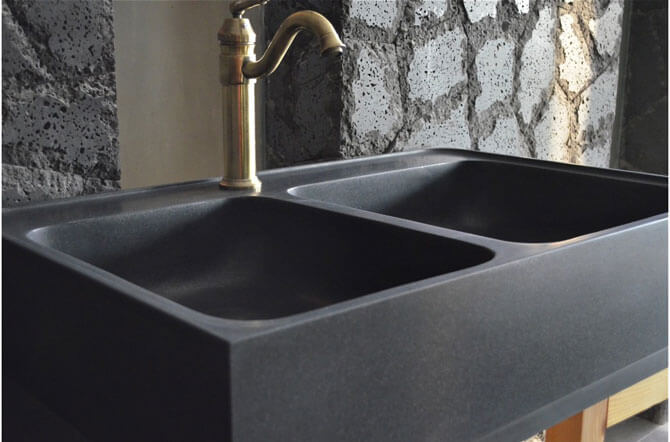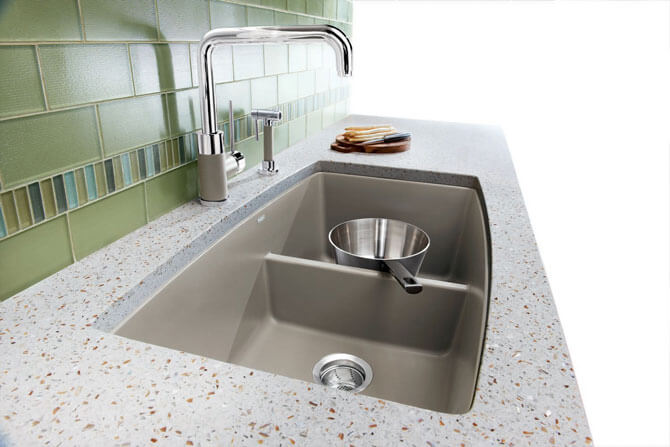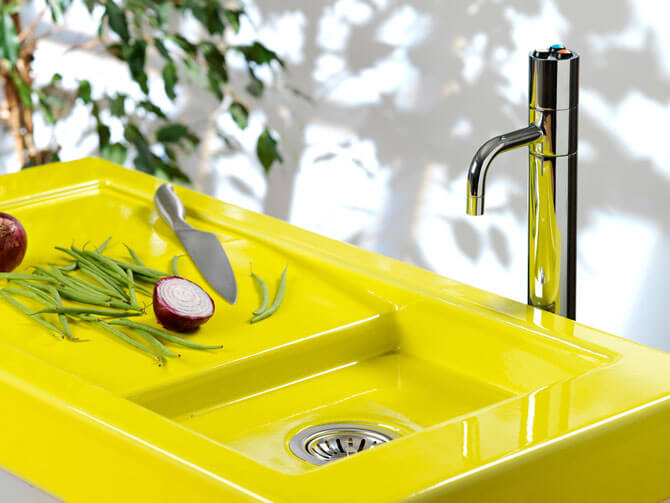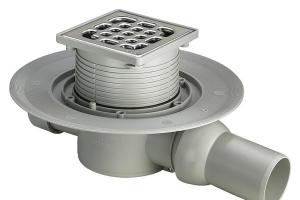Stone sinks for the kitchen
Stone sinks are increasingly used in luxury kitchen interiors. They are superior to models made from other materials in terms of functionality, quality and appearance. Today, artificial stone is used for the production of kitchen sinks. It is great for making sanitary ware, because it can be used to create a sink of almost any shape. By its appearance, artificial material cannot be distinguished from natural. The many advantages of synthetic stone sinks have made them increasingly popular.
Manufacture of sinks made of artificial stone
The use of synthetic stone for the manufacture of sanitary ware began after the development of a qualitatively new material that successfully combined the plasticity and characteristics of natural stone. The leadership in its development belongs to the American company DuPont. In 1966, she developed and patented a new composition, called Corian.
The composition of the new material is rather complicated. It includes many components, of which the main ones are the filler and the binder composition.
Various types of crushed natural stone are used as a filler. Here they use granite, marble, quartz and much more. As a binder, polymer resins are used, which give the material plasticity. Sometimes, to enhance this property, special additives are used - dolomite clays. There are also various plasticizers, hardeners and dyes.
The prepared material is called a compound. It is poured into a special container - a mold for making a finished sink. Beforehand, the container is thoroughly cleaned and degreased so that even the smallest foreign body does not spoil the shell structure. Then the form is covered from the inside with a special gel. This substance covers the finished sink with a protective film during production at high temperatures. The gel also facilitates easy removal of the product from the container.
This is how modern sinks made of artificial stone are made. The compound has high ductility, which makes it easy to cast a product of any shape. The use of special dyes in the composition of the substance allows you to create sanitary ware that is indistinguishable in color and texture from natural stone. In terms of hardness and wear resistance, such sinks are also not much inferior to natural materials, but the plasticity of a synthetic substance is much higher, so it is not at all easy to damage a Corian sink.
Types of artificial stone
The modern market offers sinks made of various materials. The most popular types of artificial stone are corian, artificial granite and liquid stone.
Corian sinks have been popular for decades. The composition of this material allows you to make the finished product absolutely smooth. The material does not have pores and recesses, therefore it does not absorb moisture and does not accumulate dirt. Corian sinks are easy to clean, easy to care for, and retain their appearance for many years.
Corian sinkAnother popular sink material is artificial granite. It is based on small granite chips, bound with a polymer resin. The more natural granite in the compound, the more expensive the products made from it. The manufacturing technology of synthetic granite sinks involves filling molds in vacuum chambers. In this case, it is possible to achieve perfect surface smoothness and strict observance of dimensions.
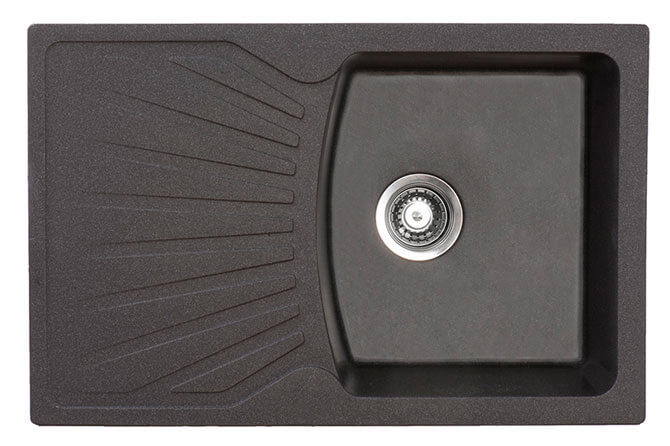 Synthetic granite sink
Synthetic granite sink Relatively recently, a new composite material has appeared on the market, which is characterized by high strength. This liquid stone (Granicoat). Products can be made from it by pouring the composite into blanks. However, this is not its only application. Liquid stone can be successfully sprayed onto ready-made shells, which leads to a significant hardening of its surface. In this way, it is possible to produce sinks that are distinguished by their overall lightness and strength of the surface layer. In addition, this material is remarkably durable. Manufacturers give a 15-year warranty on the use of a sink made of liquid stone. However, as practice shows, such sinks serve much longer without losing their performance.
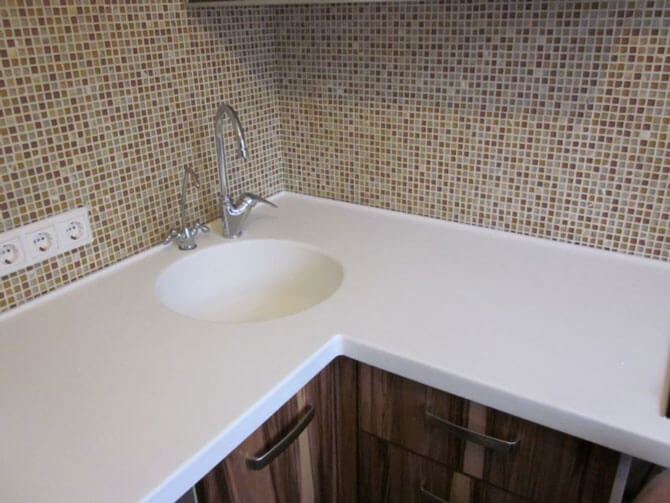 Granicoat liquid stone sink
Granicoat liquid stone sink The choice of sinks for the kitchen is not limited to the above materials. Products are made of artificial marble, onyx, as well as materials such as Wilsonart or Top Stone. All of them are made using different technologies, but their performance characteristics are largely similar.
Pros and cons of stone sinks
Modern sinks made of stone have many undeniable advantages over products made from other materials. Their main advantages are: aesthetics, hygiene, excellent performance and durability.
Advantages
- Stone sinks have an excellent stylish and modern look. A wide variety of models allows you to choose the right sink for the most sophisticated kitchen interior. Sinks are available in a variety of colors, which makes it much easier to choose a sink for a particular kitchen color scheme. The sink, mounted on a worktop made of artificial stone, matched to match it, looks especially beautiful.
- The surface of artificial stone is practically devoid of pores, and this is very important in the kitchen, where dirt, soot and grease accumulate on any surface. Such a sink, thanks to its ideal smoothness, is very easy to wash, which means that dirt and bacteria will not accumulate on it. Even an old stain can be easily removed with water, a sponge and a regular detergent.
- By their own performance a stone sink is no worse than a metal one, and in some respects even much better. It does not deteriorate and does not deform from changes in temperature and humidity, successfully resists mechanical stress. From direct sunlight, the product will not lose color. Even prolonged chemical exposure to detergents will not deteriorate its appearance. Such a sink is more massive than a metal one, so the noise of a jet of water from an open tap is almost inaudible.
- Another important advantage of all types of stone sinks is durability. They serve for decades and do not lose their original appearance, luster and color.
Flaws
- There are few serious disadvantages of artificial stone sinks. Chief among them is high price. Products made from this material have been on sale for decades and their prices have dropped significantly. But despite this, the stone sink is still out of reach for most potential buyers.
- Some disadvantages are associated with manufacturing defects products. If there is a microcrack in the wall of the sink, during operation it can lead to the appearance of a through hole.
- Sometimes, when the hot water is suddenly turned on, the seams between the sink and the countertop are depressurized. But this defect is easily eliminated by covering the seams with sealant.
How to install a stone sink
In modern kitchen sets, stone sinks are perfectly combined with countertops made of the same material in which they are mounted. Such installation is quite complicated and is carried out only by specialists. At the same time, the seams between the sink and the countertop are almost invisible. It is not recommended to try to carry out such an installation with your own hands, since the quality of the installation, most likely, will not be up to par.
If the stone sink needs to be installed in a regular worktop cutout, this installation is not too complicated. It may well be done by hand. By following the step-by-step instructions below, you can quickly and efficiently install an artificial stone sink in your kitchen.
- The first step is to cut a hole in the countertop. To do this, attach the sink to the back of the countertop and draw the outline of the future hole. If the outline is rectangular or round, this is easy to do. With a complex contour, you first need to make a template from cardboard or paper, and then apply the contour to the back of the countertop in the right place. Cut a hole with a jigsaw.
The edge of the hole in the countertop must be treated with a sealant or a special sealing tape should be laid on it. You also need to process the perimeter of the hole on the top side of the countertop. After that, the sink can be carefully installed in the countertop. Then it must be firmly fixed with special screws to the underside of the tabletop. For this, a regular screwdriver will do. - When the sink is firmly fixed, you need to install and fix the mixer, and then connect it to the water pipes, and connect the siphon to the drain hole of the sink.
Now you need to remove the excess sealant and wait until it hardens. After that, the sink can be operated.
Caring for a stone sink
Stone sinks have a long service life. But in order for the sink to serve for many years, it is necessary to properly care for it and follow some rules of operation. They are very simple, but following them, you can significantly increase the service life of the product and not worry about buying a new one for a long time.
- A sink made of stone, unlike a metal product, is quite fragile; with a strong impact, it can crack or even split. After that, it will have to be replaced. Therefore, you should try not to drop heavy objects into it.
- It is advisable not to place hot objects with temperatures over 280ºC to avoid damage to the surface of the sink.
- The joints of the countertop and sink must be sealed so that water and grease do not get into them. It is necessary to monitor their integrity.
- When caring for a stone sink, do not use acids and chlorine-containing detergents. Also, do not clean the surface with metal sponges, as they can scratch the sink.
By following these simple requirements, you can preserve the integrity and appearance of the stone sink for a long time. She will not lose her beauty for decades, will decorate the kitchen for a long time and delight the owner.
Photo of stone sinks
